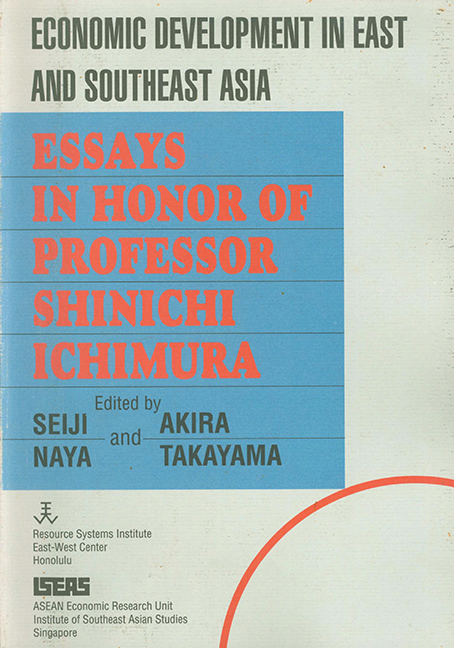Book contents
- Frontmatter
- Preface
- Shinichi Ichimura, 1925-
- CONTENTS
- Introduction
- Contributors to This Volume
- I Structural Change and Economic Development in Developing Asia in the 1990s
- II Explaining the Success of the Four Little Dragons: A Survey
- III Taiwan's Economic Miracle: A Singaporean Perspective
- IV Singapore's Experience of Industrial Restructuring: Lessons for the Other Asian NIEs
- V Korean Industrial Policies for Declining Industries
- VI Vietnam: Recent Economic Developments and the World Economy
- VII Transition from Import Substitution to Export Expansion: The Thai Experience
- VIII Adjustment Problems of a Small Oil-Exporting Country: Did Indonesia Suffer from the Dutch Disease?
- IX A Quarterly Econometric Model of the Hong Kong Economy
- X The Effect ofRicardian Rent Extracting on Macroeconomic Performance
- XI Direct Foreign Investment and the Economic Development of Korea
- XII Japanese Investment in Thailand: Looking Back and Into the Future
- XIII The Effects of Direct Foreign Investment on Taiwan: A Macroeconometric Investigation
- XIV A Reform of the Foward Foreign Exchange Market and Foreign Exchange Rate Determination Policy in Korea, with Foreign Exchange Policy Experiences of Taiwan
- XV Interest Rate and Foreign Exchange Liberalization in Taiwan in the 1980
- XVI Manifold Dilemmas behind External Debt Management
- XVII Agricultural Growth and Food Imports in Developing Countries: A Reexamination
- XVIII The Transformation of Rural Asia and Economic Development Theory and Policy
- XIX The ASEAN Summit and ASEAN Economic Cooperation
- XX The Role of Developing Countries in the New GATT Round
- XXI The Emerging Global Economy and the Role of the Asian NIEs
- Index
XIII - The Effects of Direct Foreign Investment on Taiwan: A Macroeconometric Investigation
Published online by Cambridge University Press: 21 October 2015
- Frontmatter
- Preface
- Shinichi Ichimura, 1925-
- CONTENTS
- Introduction
- Contributors to This Volume
- I Structural Change and Economic Development in Developing Asia in the 1990s
- II Explaining the Success of the Four Little Dragons: A Survey
- III Taiwan's Economic Miracle: A Singaporean Perspective
- IV Singapore's Experience of Industrial Restructuring: Lessons for the Other Asian NIEs
- V Korean Industrial Policies for Declining Industries
- VI Vietnam: Recent Economic Developments and the World Economy
- VII Transition from Import Substitution to Export Expansion: The Thai Experience
- VIII Adjustment Problems of a Small Oil-Exporting Country: Did Indonesia Suffer from the Dutch Disease?
- IX A Quarterly Econometric Model of the Hong Kong Economy
- X The Effect ofRicardian Rent Extracting on Macroeconomic Performance
- XI Direct Foreign Investment and the Economic Development of Korea
- XII Japanese Investment in Thailand: Looking Back and Into the Future
- XIII The Effects of Direct Foreign Investment on Taiwan: A Macroeconometric Investigation
- XIV A Reform of the Foward Foreign Exchange Market and Foreign Exchange Rate Determination Policy in Korea, with Foreign Exchange Policy Experiences of Taiwan
- XV Interest Rate and Foreign Exchange Liberalization in Taiwan in the 1980
- XVI Manifold Dilemmas behind External Debt Management
- XVII Agricultural Growth and Food Imports in Developing Countries: A Reexamination
- XVIII The Transformation of Rural Asia and Economic Development Theory and Policy
- XIX The ASEAN Summit and ASEAN Economic Cooperation
- XX The Role of Developing Countries in the New GATT Round
- XXI The Emerging Global Economy and the Role of the Asian NIEs
- Index
Summary
Introduction
Several studies have shown direct foreign investment (DFI) in Taiwan to be significant in a number of respects during the post-war period, particularly since the mid-1960s. However, because of problems in accurately measuring the impacts of DFI and other difficulties associated with macroeconometric models of developing economies, description of trends and patterns of DFI and foreign multinational corporation (MNC) activities have been the typical mode of analysis; and only a few attempts have been made to formally integrate the effects of DFI into macroeconometric models of the Taiwanese economy.
A few studies have attempted single-equation econometric analyses of macroeconomic relationships between DFI flows and trade and/or output flows (e.g., Hsiao and Hsiao 1984; Kqjima 1985; Ramstetter 1987). DFI flows have also been hypothesized to determine the level of exports, fixed investment, and inventory investment in the macroeconometric model of Lee and Yu (1987). Although there is some rationale for including foreign capital flows as determinants of investment in developing economies, economic theory suggests that output and trade are more properly viewed as functions of capital stocks rather than investment flows.
The primary goal here is thus to develop a macroeconometric model of the Taiwanese economy highlighting the role of DFI using specifications that are consistent with economic theory. In this respect, the crux of the issue is the choice between flows or stocks in specifying DFI. Some insights can be found in an overview of the more important characteristics of DFI in Taiwan in the section below. Since the vast majority of DFI in Taiwan has flowed into manufacturing, a simple two-sector (manufacturing and nonmanufacturing), two-market (goods and labor) macroeconometric model of the Taiwanese economy was constructed, estimated, and simulated for the period 1972-86. After obtaining the base solution, DFI, which is exogenous, is shocked and shock simulations are compared with base case simulations to ascertain the effects of higher levels of DFI on the Taiwanese economy during this period.
Foreign Multinational Activity and Taiwan's Investment, Employment, Value Added, and Trade
In the past thirty years, DFI has generally accounted for a small portion of total fixed investment in Taiwan. Before 1972, the share of DFI to total fixed capital formation averaged from 3 to 5 percent each year. This share fell to less than 2 percent in 1972 and remained low in subsequent years.
- Type
- Chapter
- Information
- Economic Development in East and Southeast AsiaEssays in Honor of Professor Shinichi Ichimura, pp. 202 - 227Publisher: ISEAS–Yusof Ishak InstitutePrint publication year: 1990



